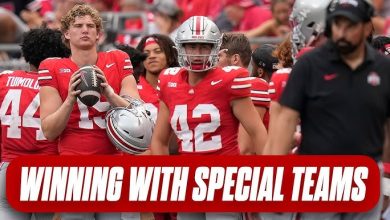No. 13 A&M completes the sweep of Oklahoma by controlling the glass.

In a highly anticipated matchup between two of the top teams in the conference, No. 13 Texas A&M cemented its dominance by sweeping Oklahoma in the season series, this time claiming a resounding victory with an emphatic performance on the boards. A relentless effort on both offense and defense allowed the Aggies to control the glass throughout the game, ultimately leading to a decisive win that further solidified their place as one of the premier teams in college basketball.
The Aggies, under the leadership of head coach Buzz Williams, were simply too much for Oklahoma in this one. From the opening tip, it was clear that controlling the glass would be the game plan, and Texas A&M executed it flawlessly. This victory was more than just another win; it was a statement that the Aggies are capable of competing at the highest level, and their success this season is built on solid fundamentals, defensive discipline, and relentless hustle.
This article breaks down the key moments from the game, the pivotal role of Texas A&M’s rebounding effort, standout performances from players, and what this win means for both teams moving forward in the 2024-2025 season.
Texas A&M’s Focus on Rebounding
Rebounding is often an overlooked aspect of the game, but it is one of the cornerstones of any successful team. For Texas A&M, the emphasis on controlling the glass was evident from the start. The Aggies brought an aggressive mindset to the boards, refusing to allow Oklahoma any second-chance opportunities. The emphasis on rebounding had been evident in the team’s preparation leading up to the game, as Williams and his staff consistently stressed the importance of limiting the opposition’s offensive rebounds and maximizing their own opportunities on the offensive end.
Throughout the game, it was clear that Texas A&M’s commitment to rebounding was the difference-maker. The Aggies’ frontcourt players, led by Henry Coleman III, dominated the boards, and their tenacity on the glass kept Oklahoma from gaining any momentum. Texas A&M finished with a 55-35 rebounding advantage, including a stunning 18 offensive rebounds that led to multiple second-chance opportunities and putbacks.
Henry Coleman III: The Anchor of the Aggies’ Glass-Control Effort
While the entire team contributed to the dominant rebounding performance, it was Henry Coleman III who served as the anchor. The Aggies’ 6’8” forward was a force to be reckoned with on both ends of the floor, but his ability to crash the boards and assert himself in the paint was particularly impressive. Coleman, who had been quietly efficient for most of the season, emerged as the game’s most valuable player, finishing with a game-high 14 rebounds (7 of which were offensive). He also added 17 points, making it clear that he is one of the top frontcourt players in the conference.
Coleman’s rebounding prowess played a crucial role in limiting Oklahoma’s offensive opportunities. Every time the Sooners tried to push the ball, Coleman seemed to be right there, securing the ball and denying them the chance to set up another scoring possession. Coleman’s ability to grab boards in traffic, whether off missed shots or contested rebounds, was a key factor in Texas A&M’s ability to take control of the game. His presence on the glass allowed the Aggies to dictate the tempo, forcing Oklahoma to play at their pace rather than the other way around.
In addition to his rebounding, Coleman’s ability to space the floor offensively and finish plays in the paint made him an indispensable asset. His diverse skill set also allowed the Aggies to extend their lead and make critical plays down the stretch.
A Collective Effort: The Entire Aggies Team Steps Up
While Coleman’s individual performance was outstanding, the entire team contributed to Texas A&M’s dominance on the boards. The Aggies are known for their physicality, and that was on full display throughout the game. Even when Coleman was out of the game for short stretches, other players stepped up in his absence, ensuring that the team maintained its edge.
Dexter Dennis, a senior guard who has earned a reputation as one of the best defenders on the team, played a key role in the rebounding effort. Dennis was instrumental in securing critical rebounds late in the game, particularly on the defensive end. His ability to box out and grab long rebounds prevented Oklahoma from getting back into the game, particularly as the Sooners mounted a late rally.
Tyrece Radford, another key player for the Aggies, also contributed significantly to the rebounding effort, finishing the game with 9 rebounds and 13 points. Radford’s all-around play, coupled with his ability to pull down boards and create second-chance opportunities, further emphasized the team’s commitment to playing hard-nosed basketball.
Other key contributors included Julius Marble, who added 8 rebounds, and Wade Taylor IV, who was not only a force offensively but also showed his grit by grabbing several important boards in clutch moments. Every player who saw the floor in this game had a hand in the team’s total rebound tally, which is a testament to the depth and effort of the entire roster.
Oklahoma’s Struggles: Limited Opportunities on Offense
For Oklahoma, this game was a tough one to swallow. Despite the team’s offensive talent, they were unable to sustain any offensive rhythm due to Texas A&M’s suffocating defense and rebounding dominance. The Sooners struggled with turnovers and missed opportunities on the glass, allowing Texas A&M to control the tempo of the game.
Oklahoma’s frontcourt players, including Brady Manek, were unable to contend with the Aggies’ physicality in the paint. Manek, who had been a force throughout the season, was held to just 6 rebounds in this contest and had difficulty establishing position on the boards. Oklahoma’s inability to secure offensive rebounds and limit Texas A&M’s second-chance points proved to be a significant disadvantage, as the Aggies capitalized on every opportunity.
The Sooners also struggled with their shooting. While they had several players capable of creating their own shots, the Aggies’ defense, led by Dexter Dennis and Radford, kept them off-balance for much of the game. Oklahoma’s shooting percentage dipped as a result of Texas A&M’s suffocating defense, and the lack of easy scoring opportunities further compounded their struggles.
Despite some bright moments from Grant Sherfield and Jalen Hill, who combined for 31 points, the Sooners were unable to overcome Texas A&M’s physicality and dominance on the boards. As the game wore on, it became clear that Oklahoma simply couldn’t match the Aggies’ intensity, and their inability to rebound consistently proved to be the deciding factor in the game.
The Aggies’ Balanced Offensive Attack
While Texas A&M’s rebounding was the primary storyline, the Aggies also showcased a balanced offensive attack. The team shot 47% from the field and 38% from three-point range, taking advantage of open shots created by their strong defense and rebounding. The Aggies weren’t reliant on one player to carry the scoring load; instead, it was a team effort that spread the wealth across multiple players.
Wade Taylor IV was especially effective in directing the offense, contributing 15 points and 7 assists. His court vision allowed Texas A&M to get high-quality looks, whether from the outside or inside the paint. As a dynamic point guard, Taylor’s ability to distribute the ball and make plays for his teammates was a key factor in Texas A&M’s success.
Tyrece Radford, who had been playing some of the best basketball of his career, continued his stellar play with 13 points and timely scoring. Radford’s ability to get to the rim and finish through contact made him a difficult matchup for Oklahoma’s defense, and his rebounding and defensive contributions were just as valuable.
While Coleman dominated inside, Marble added crucial points in the paint and on the glass. Julius Marble’s 10 points and 8 rebounds helped provide additional balance to the Aggies’ offense, ensuring they didn’t become one-dimensional.
What This Win Means for Texas A&M
The victory over Oklahoma is another significant step for Texas A&M as they continue to prove themselves as one of the top teams in the nation. The Aggies have been steadily climbing the rankings, and this win only adds to their resume as they move closer to postseason play. Their ability to control the glass against a talented team like Oklahoma demonstrates their physicality and depth, which will be crucial as they face tougher opponents in the postseason.
The Aggies’ performance also speaks to their well-rounded nature. This is not a team reliant on one player or one aspect of the game. Instead, Texas A&M has shown it can win games in multiple ways, whether by dominating on the glass, playing stifling defense, or running an efficient offense. If the Aggies can maintain this level of play throughout the season, they will be a serious contender in both the SEC and NCAA Tournament.
What’s Next for Oklahoma?
For Oklahoma, this loss was a tough one, but it’s far from the end of the road. The Sooners have the talent to bounce back, but they will need to refocus their efforts on rebounding and maintaining their offensive flow. Head coach Porter Moser will look to regroup his team and address the issues that led to their defeat.
Oklahoma has the talent to make a run at the NCAA Tournament, but they’ll need to tighten up their defense and find ways to be more consistent on the glass moving forward.









